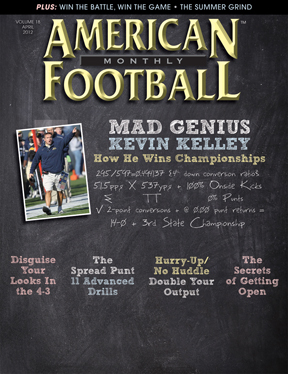Article CategoriesAFM Magazine
|
Making the Most of the Hurry-Up, No-Huddle Offense - Calling plays at the line can let you double your offensive snaps.by: Steve Dorsey© More from this issue His team had just been walloped 56-7 in its spring game last May and Palm Beach Gardens (FL) head coach Chris Davis knew he had to make some adjustments or face another mediocre .500 season. He just wasn’t sure what he was going to change in his system. His teams had been 4-5 and 5-5 in 2009 and 2010. A few weeks later, Davis was attending a coaches clinic where he heard Gus Malzahn, then the offensive coordinator at Auburn, speak on the advantages of a no-huddle, hurry-up offense. Davis had met Malzahn last spring when Malzahn was on a recruiting trip to Florida. He made it a point to speak with Malzahn at the clinic and began quizzing him more about this offense. Malzahn invited Davis to visit him and Auburn offensive line coach Jeff Grimes the following week to discuss the scheme further. Davis graciously accepted the in....The full article can only be seen by subscribers.
|
|
|||||||
| HOME |
MAGAZINE |
SUBSCRIBE | ONLINE COLUMNISTS | COACHING VIDEOS |
Copyright 2025, AmericanFootballMonthly.com
All Rights Reserved





